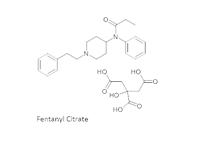
CAS Number: 990-73-8
Formula: C28H36N2O8
Molecular Weight: 528.59 g/mol
Method of Analysis: Based on: USP, BP
Application: Opioid analgesic, adjunct in anaesthesia Oral and Transdermal fentanyl is often used in the management of chronic pain including cancer pain. Intravenous fentanyl is often used for anesthesia and analgesia. It is also administered in combination with a benzodiazepine, such as midazolam, to produce sedation for procedures such as endoscopy, cardiac catheterization, and oral surgery, or in emergency rooms. Fentanyl is sometimes given intrathecally as part of spinal anesthesia or epidurally for epidural anesthesia and analgesia.
Mechanism:
Fentanyl is a potent opioid analgesic with a rapid onset and short duration of action. The principal actions of therapeutic value are analgesia and sedation. At a dose of 100 micrograms (2 mL), the analgesic activity of fentanyl is approximately equivalent to 10 mg of morphine or 75 mg of pethidine. Fentanyl differs from morphine by its short duration of analgesic activity, lack of emetic activity, and minimal hypotensive activity.
The action of fentanyl is qualitatively similar to those of morphine and pethidine, i.e. analgesia, euphoria, miosis, bradycardia, respiratory depression, bronchoconstriction, muscle rigidity and suppression of cough reflexes. These effects can be reversed by specific narcotic antagonists, e.g. naloxone. As with morphine, fentanyl -induced bradycardia from vagal stimulation is blocked or reversed by atropine. Alterations in respiratory rate and alveolar ventilation, associated with opioid analgesics may last longer than the analgesic effect. As the dose of the opioid is increased, the decrease in pulmonary exchange becomes greater. Larger doses may produce apnoea. The behavioural effects in mice of fentanyl and morphine are similar, and with toxic doses death is due to respiratory depression. The respiratory depressant properties of fentanyl appear to be due to a central effect by decreasing the sensitivity of the respiratory centre to carbon dioxide. In an experiment in cats, no effect on neuromuscular transmission was observed in the presence of severe respiratory depression.
Histamine assays and skin wheal testing in man, as well as in vivo testing in dogs, indicate that histamine release rarely occurs with fentanyl. Experiments in dogs, have shown that intravenously administered fentanyl at doses 2-4 times the recommended human dose, had minimal effect on blood pressure and heart rate. Much higher doses of fentanyl citrate, ranging from 100-400 micrograms/kg, produce an immediate fall in blood pressure, followed by partial recovery, and a sustained hypotensive effect lasting up to 30 minutes.
Fentanyl produces a minimum of cortical depression, and it is suggested that it exerts its action by filling receptor sites located in the thalamus, mid-brain, and spinal cord. A specific opioid antagonist, e.g. naloxone, produces reversal of respiratory, cardiovascular, miotic, and motor incoordination effects, as well as analgesia, euphoria, and sedation. Rigidity of the diaphragm and intercostal muscles can be eliminated by succinylcholine. Cholinergic effects, e.g. brady-cardia, are reversed by atropine.
Storage conditions: Room temperature
Packaging: glass vial